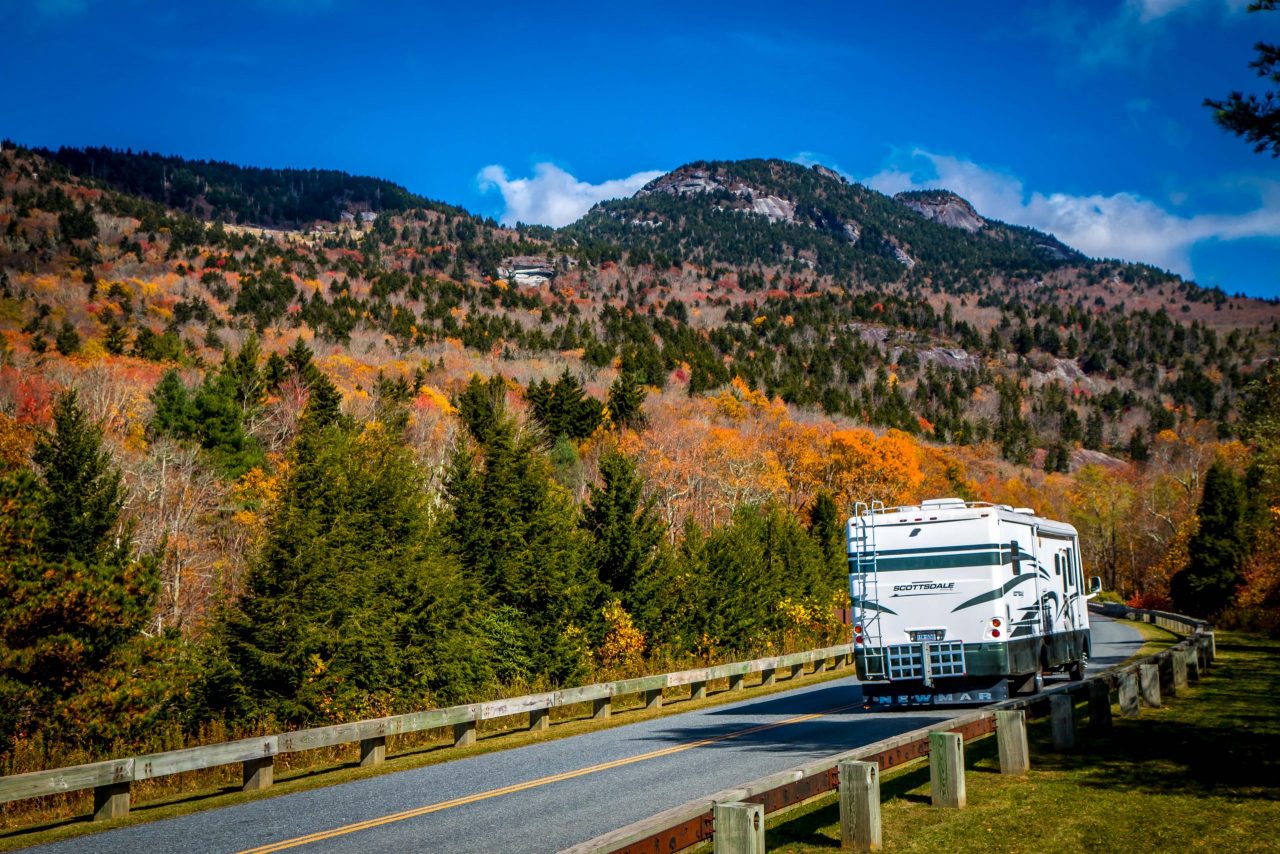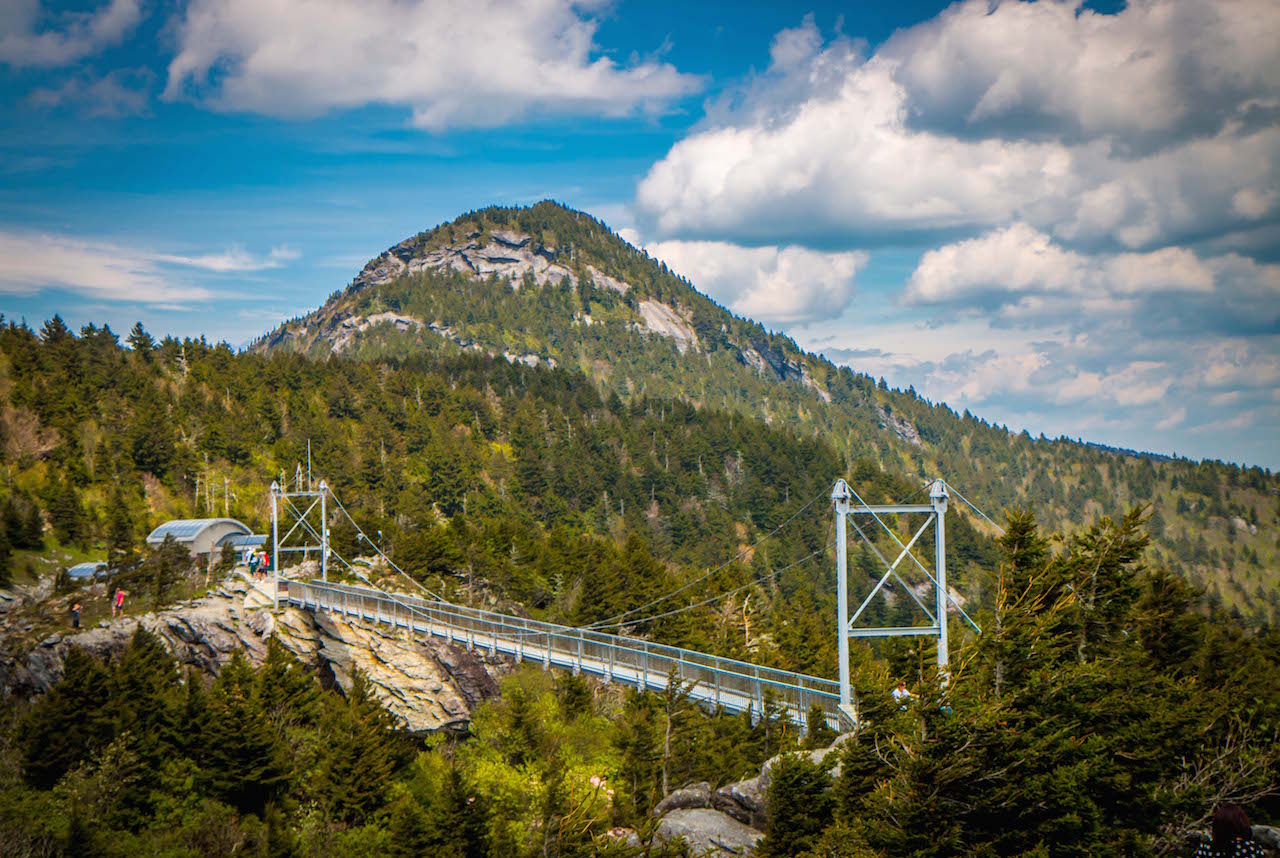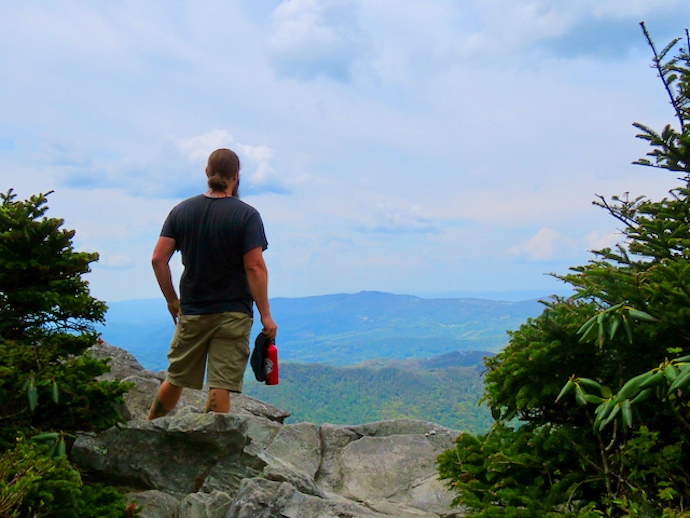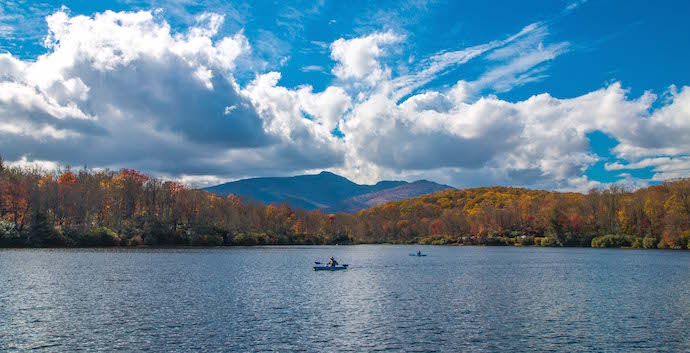For me, the monolithic majesty of Grandfather Mountain preceded itself.
On a few occasions in the past, my wife Emma and I visited friends who had a distant view of it from their mountain cabin. They were always thrilled to point the iconic summit out as a centerpiece of the High Country landscape.
In a collection of lofty mountains in Western North Carolina, Grandfather is the highest in both Watauga and Caldwell Counties. Plus, it simply has a name that suggests grandiosity.
That was enough to catch our attention, and we’d been wanting to climb it for years.
However, that distant panorama of Grandfather Mountain had hardly prepared us for how magical hiking up to Callaway Peak was going to be.
Little did we know that the venerable mountain is truly a natural wonder, with more than a dozen distinct ecological zones and a plethora of creeks, springs, and the Watauga River adding to the scenery.
In addition to sweeping views of the NC Piedmont below, there was even more magic inside the forest.
Check out our guide to making the most of a visit to Grandfather Mountain State Park, including everything from hiking trails and backcountry camping to the Mile-High Swinging Bridge (part of the adjacent paid attraction) and more!
READ MORE: Top 15 NC State Parks in the North Carolina Mountains

Grandfather Mountain State Park Info
ADDRESS: 9872 Hwy 105 S., Suite 6, Banner Elk NC 28604
PHONE: 828-963-9522
GRANDFATHER MOUNTAIN STATE PARK RESERVATIONS: 1-877-722-6762
PARK HOURS: Nov-Feb 8:00am-6:00pm, Mar-May/Sep-Oct 8:00am-8:00pm, Jun-Aug 8:00am-9:00pm
OFFICE HOURS: Mon-Fri 8:00am-4:30pm
ENTRY FEES/PASSES: None for the state park itself. The Mile-High Swinging Bridge is part of the adjacent Grandfather Mountain attraction, which charges a fee.
OFFICIAL WEBSITE: NC Parks
RESERVATIONS WEBSITE: Reserve America
DIRECTIONS FROM BOONE NC: From Boone, take the NC-105 S towards Banner Elk. The entrance to the park will be on the left side of the road. It’s between 11 and 12 miles, and the name of the road to the Profile Trail entrance is The Glens Blvd. For the Boone Fork entrance, follow directions below.
DIRECTIONS FROM BANNER ELK NC: From Banner Elk’s Main St, head south on Shawneehaw Ave for 2.9 miles, where it turns into NC-184 S. Follow the road for another 1.4 miles, then make a right on NC-105 S. Follow NC-105 S for 4 miles, then turn left onto US-221 N. Take that for 3.1 miles, then turn left onto the Blue Ridge Parkway. The entrance will be 1.8 miles down, at BRP Milepost 299.9.
READ MORE: 15 Best Things to Do in Boone NC (Blue Ridge Parkway MM 291.8)

The History of Grandfather Mountain State Park
Grandfather Mountain has been an iconic landmark in the North Carolina mountains since long before there was a state of North Carolina. Its renown has only increased over time.
The Cherokee people knew the mountain as Tanawha, meaning “fabulous hawk (or eagle).” Early European explorers later named it Grandfather because they claimed they saw the face of an old man in one of the cliffs.
The famous frontiersman Daniel Boone hunted in the forests of Grandfather Mountain in the 1760s. Famed botanist Andre Michaux falsely claimed he had climbed the highest mountain in North America when he summited Grandfather Mountain in 1794 and saw the expansive view.
Another botanist, Asa Gray, discovered a rare lily— now known as Gray’s Lily—blooming in the mountain’s high-altitude grasslands in 1841.
And famed naturalist John Muir couldn’t speak highly enough of the view from atop Grandfather, claiming that it had healed his bronchitis when he visited in 1898.
In the early 1900s, the Linville Improvement Company helped to develop areas around Grandfather Mountain, and even made the trail to “Cliffsides” large enough for early automobiles.
In 1952, Hugh MacRae Morton (the former head of Linville Improvement Company) became the sole owner of Grandfather Mountain.
READ MORE: The 15 Best Things to Do in Cherokee NC & the Qualla Boundary

He opened it up to more tourism by widening the road and building the famous Mile-High Swinging Bridge. He also purchased a male and female black bear, intending that they would be reintroduced to the wilderness.
But when Mildred the Bear wouldn’t revert to a wild lifestyle, she was recaptured for her own safety and kept in an enclosure, becoming yet another Grandfather Mountain attraction for tourists.
In the 1990s, the mountain started moving more into the public sphere. It was designated as a unit of the UNESCO Biosphere Reserve for Southern Appalachia.
After Hugh Morton passed away in 2006, his heirs sold the “backcountry” portion of the property (which is now Grandfather Mountain State Park) to the state of North Carolina.
They also transferred ownership of the developed travel attraction to a non-profit, the Grandfather Mountain Stewardship Foundation, which is geared towards preserving the mountain as a wild area.
READ MORE: The 20 Best Things to Do in Blowing Rock NC

Things to Do in Grandfather Mountain State Park
Hiking Trails
The 12+ miles of Grandfather Mountain State Park hiking trails in the backcountry are the adrenaline-pumping arteries into the heart of nature.
Aside from the Nuwati Trail, which is a short and easy 1.2 miles, all of the treks on Grandfather Mountain are rated moderate, strenuous, or advanced.
For most motivated visitors, the ultimate goal is to reach Calloway Peak, which is– at 5,946 feet– the highest point on the mountain.
There are several ways of getting there:
- The Profile Trail is best accessed via NC-105, in the northern reaches of the park. It’s a strenuous 3.6-mile trail that intersects with Grandfather Trail. Another mile or so on Grandfather Trail gets you to the peak.
- From the eastern entrance of the park at the Boone Fork Parking Area, hikers can take the Blue Ridge Parkway route, from the Tanawha Trail to Daniel Boone Scout Trail to Calloway Peak (8+ miles roundtrip). Or you can extend the hike by including a detour on the Nuwati Trail and Cragway Trail (around 10 miles roundtrip). The Daniel Boone Scout Trail includes ladders and cables to help with steep sections.
- From the Grandfather Mountain roadside attraction, you would need to take the Grandfather Extension Trail to Grandfather Trail and hike the ridge from there. It’s about six miles round-trip. This trail, however, is designated as advanced because there are extra steep parts where cables are absolutely necessary.
Shorter hikes include taking Nuwati Trail to Storyteller’s Rock for great views of Calloway Peak and Boone Bowl.
Or you can view the park on the Black Rock Trail (from the roadside attraction) to get views of Attic Window and MacRae Peak, as well as the Mile-High Swinging Bridge, Beacon Heights, and Grandmother Mountain.
READ MORE: The 10 Best Boone NC Hiking Trails to Explore

Backpack Camping
Camping has to be listed as one of the best things to do at Grandfather Mountain State Park, because this is much more challenging and rewarding than merely pulling up in a car to pop a tent.
There are 13 backcountry campsites in the park, and they are as far from run-of-the-mill as it gets.
This kind of camping is definitely not for everyone. But if swinging in a hammock overlooking a vast landscape below (with no cell service, rangers, or restrooms in sight) sounds like your cup of tea, then get the kettle boiling!
Campfires, where permitted, must come from collecting dead wood. Water comes from intermittent streams. And wild bears are about, which means your food must be securely stored away from tents and hung out of reach.
There is a camping fee ($15, or $35 for the group site), and the park recommends making reservations prior to arrival. All campers must fill out a permit once on site.
READ MORE: The 20 Best Pisgah National Forest Hiking Trails

Join a Guided Park Ranger Walk
Despite being one of the most popular tourist destinations in Western North Carolina, Grandfather Mountain remains a largely wild place.
There are natural walking paths, just a few tent sites, and a mountain-sized serving of rugged beauty.
The park is absolutely stunning, with cool streams bubbling over rocky beds and several types of forest, including high-altitude spruce-fir forest.
These special forests form little mountaintop islands across Western North Carolina, which are only present in areas over 5,000 feet in elevation
The opportunity to take a walk with a knowledgeable park ranger is well worth timing your visit carefully. There are several events throughout the year that afford this kind of interaction, guidance, and insider info.
Sometimes the park offers informal conversations with a ranger over coffee (BYOC: bring your own cup). This happens in the Bear Paw State Natural Area, located just north of Grandfather Mountain State Park.
READ MORE: The 15 Best Things to Do in Bryson City NC & Swain County

Grandfather Mountain Attraction
While technically not part of Grandfather Mountain State Park, the scenic Grandfather Mountain tourist attraction (which charges an admission fee) has been around long before the park was established.
The most famous draw here is the Mile-High Swinging Bridge, a 228-foot suspension bridge that crosses over an 80-foot gorge at more than a mile above sea level.
The original bridge was built in 1952. But the current bridge (which uses the original towers) was rebuilt in 1999 using modern materials. The bridge is now made of galvanized steel, so that employees don’t “have to hang out over the gorge to paint the span.”
The attraction also has wildlife habitats (expanded from Mildred’s original enclosure) that provide glimpses of historically native animals– Cougars, Black Bears, River Otters, Bald Eagles, and Elk—in their native habitats.
All of these animal ambassadors were rescued, injured, or orphaned, and could not survive if they were returned to the wild.
There’s also a nature museum that’s currently being expanded, additional Grandfather Mountain hiking trails (including an interpretive trail for families), several scenic overlooks, and great places for picnics.
READ MORE: The 15 Best Blue Ridge Parkway Waterfalls in North Carolina

Grandfather Mountain State Park Lodging
Backcountry Campsites
For the rustically adventurous, Grandfather Mountain offers 13 hike-in campsites to choose from.
The lower sites allow campers to have campfires (dead wood must be gathered from the forest, no outside wood allowed), while the higher sites along Grandfather Trail prohibit them due to frequent high winds but offer up top-tier views.
All items must be carried into the campsites (at the least, a couple of miles), and all trash must be carried back out.
Black bears are in the area, so the campsites come equipped with a cable nearby for hanging food items away from the tent overnight.
READ MORE: The 10 Best Blue Ridge Parkway Hotels & Cabins in North Carolina

Nearby Campsites: Linville Falls, Julian Price Campground
For those who are less rustic, but still love to camp, there are two great Blue Ridge Parkway campgrounds nearby– the Julian Price Campground and Linville Falls Campground.
Julian Price Campground is located next to Price Lake in Julian Price Memorial Park, and it can host RVs as well as tent campers.
Located at Blue Ridge Parkway Milepost 297, about 10 miles north of Grandfather Mountain State Park, the campground has 197 sites.
The Linville Falls Campground has 70 sites, over half of which can be reserved in advance. RV camping and tent camping are both available, as are bathrooms and drinking water (but no showers).
Look for BRP Milepost 316.4, and it’s a ½-mile down the Linville Falls Spur Road, about 15 miles from Grandfather Mountain State Park.
Both of these campgrounds are excellent places to stay if you travel to see peak fall colors in North Carolina.
READ MORE: The 15 Best Blue Ridge Parkway Hikes for NC Day Trips

Banner Elk, Blowing Rock, Boone and Linville
If cabins, B&Bs, and resorts are more your speed, Grandfather Mountain State Park is very conveniently located near several tourist hubs.
Boone, the seat of Watauga County and home to Appalachian State University, is 20 miles away. This small mountain town has nice restaurants, breweries, museums, and all the infrastructure you’d expect.
Blowing Rock is a major tourist destination with cute, walkable streets and sidewalk cafes, all in a beautiful mountain setting just 15 miles from Grandfather Mountain.
Banner Elk is a smaller mountain village with some nice restaurants and a lot of nature surrounding it, including wineries and some of the best snow skiing resorts in North Carolina. It’s a mere 10 miles from the state park.
Located just 2.2 miles away, Linville is a great stop for those moving southward from Grandfather Mountain. Linville Falls is a showstopper, and Linville Gorge (“the Grand Canyon of the East”) is another rugged and beautiful natural area that’s ripe for exploration. –by Jonathon Engels; lead photo by Bret Love & Mary Gabbett




